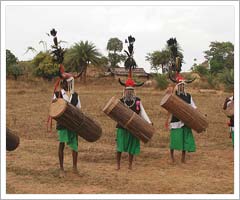History
 According to various historical literary works, inscriptions and records penned by foreign tourists, the name Chhattisgarh has originated from Dakshin Kosala, as the region was called in the ancient times. In fact, the oldest Indian epic, Ramayana, also supports the fact, where it is mentioned that Lord Ram, in the course of his exile, stayed in this land. Interestingly, during the Mughal rule, the region was popular as Ratanpur territory. Again, another theory supports the fact that the state got its name from the thirty six princely states from olden eras as the very name indicates so (Chhattis meaning thirty-six and Garh referring to fort, in Hindi). It was during the rule of the Marathas that the place got its name as Chhattisgarh and first exercised in an official certificate in 1795. According to various historical literary works, inscriptions and records penned by foreign tourists, the name Chhattisgarh has originated from Dakshin Kosala, as the region was called in the ancient times. In fact, the oldest Indian epic, Ramayana, also supports the fact, where it is mentioned that Lord Ram, in the course of his exile, stayed in this land. Interestingly, during the Mughal rule, the region was popular as Ratanpur territory. Again, another theory supports the fact that the state got its name from the thirty six princely states from olden eras as the very name indicates so (Chhattis meaning thirty-six and Garh referring to fort, in Hindi). It was during the rule of the Marathas that the place got its name as Chhattisgarh and first exercised in an official certificate in 1795.
There were various aspects accountable for the formation of this state. A heterogeneous blend of different social, cultural, political, historical and economic issues has been part of the cause of the evolvement of the state. Chhattisgarh is by and large considered as a tribal subjugated state. It houses a major population of the tribes in its territory. It is noted that in spite of the contemporary avant-garde influence prevailing in every nook and corner of the country, the tribal people of Chhattisgarh have retained their original culture and traditions. As per the 1991 census, the approximate tribal population according to the respective districts recorded at that time was as follows: Raipur – 18.6%, Bilaspur – 23.4%, Durg – 12.6%, Rajnandgaon – 25.3%, Surguja – 54.8%, Bastar – 67.7% and Raigarh – 45.5%. The most familiar tribes found in the state are Muria, Baiga, Kamars, Halbas, Gonds, Bhumja, Kawars etc. Out of these, few tribal families like the Gonds have exchanged cultural practices with the local Hindus, whereas on the other hand the orthodox tribes like the Baigas and the Kamars have maintained their originality till date. The state has seen many tribal upheavals from the late 18th century to the initial few decades of the 20th century. The rebellions varied from time to time, place to place; however the reasons behind these revolts remained almost the same. The main idea behind this political, social and economical unrest was the demand for the conventionally immutable right of the tribal societies on the natural and confined wherewithal, land and jungle. Some of the significant tribal revolts were: the Halba Rebellion (1774-79), the Bhopalpatnam Struggle (1795), the Paralkot Rebellion (1825), the Tarapur Rebellion (1842-54), the Maria Rebellion (1842-63), the First Freedom Struggle (1856-57), the Koi Revolt (1859), the Muria Rebellion (1876), the Rani Rebellion (1878-82) and the Bhumkal Movement (1910).
Raipur is the capital of the state. It is supposed to be the tenth largest state of India as per its territory. It shares its borders with Madhya Pradesh on the north-west, Maharashtra on the west, Andhra Pradesh on the South, Orissa on the east, Jharkhand on the northeast finally Uttar Pradesh on the north. Although Hindi is the official language of Chhattisgarh, yet there are influences of Dravidian languages and other languages like Oriya, Marathi and the tribal dialects. The tribal societies of the state inherit a rich cultural heritage. They are also considered to be good artisans and craftsmen. Attractive decorative items and idols carved on wood, clay samples and exquisite bamboo furniture stand as outstanding examples of their handicrafts. The Chhattisgarhi tribal sects take equal interests in dance and music. Few of the popular dance styles common among them are the Panthi, Raut Nacha Karma and Soowa. The traditional folk songs which steal a listener’s heart are Sohas, Pathoni and Bihav. These songs and music are no more restricted to the state’s boundaries, but getting worldwide recognition in the present times. Another factor which brings recognition to the territory is that the women population of Chhattisgarh is meant to be the second highest among the other states of India. Women power is respected and regarded widely throughout the state borders. |